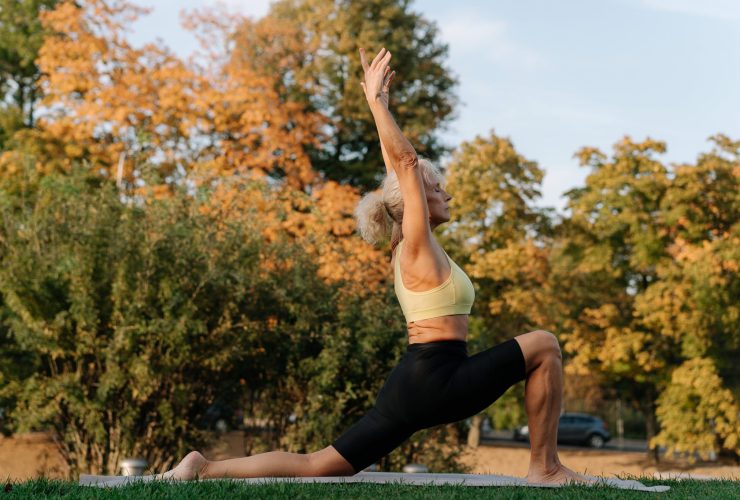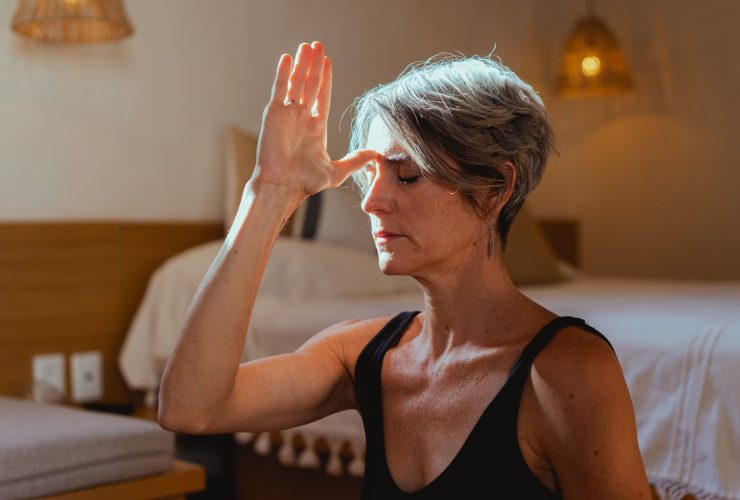With all of the hustle and bustle of today’s world, it can be difficult to consistently find moments of peace and quiet. Opportunities to completely relax can feel few and far between, no matter your age or lifestyle, which is why having a dedicated space for this purpose can be so beneficial. For those who want to have a peaceful place to unwind after a long day, or a way to relax before bed, practicing mindfulness and meditation can introduce tranquility into an otherwise hectic life.
One popular approach is to create a meditation area at home. This was popularized during the pandemic, when many found themselves isolated and bored in their homes—a feeling that seniors may find all too familiar. For many, this small, intentional act set them on the path towards mindfulness and peace by allowing them to grow and develop their meditation practice.
What is meditation?
Why exactly are meditation spaces so beneficial? To answer this question, we must first understand what meditation is and what its benefits are, both mentally and physically. Luckily, as meditation is a popular form of mindfulness, there is a lot of research into its physical and mental effects, including its multiple benefits for seniors.
The basics
Meditation is one of the most well known mindfulness practices. Originating in ancient India, the practice rapidly spread out and is now found in nearly every major religion in the world. Today, it is thought that there are an estimated 200 million to 500 million meditating people in the world. At its core, meditation focuses on noticing and living in the present moment without judgement. This can be done through a variety of physical and mental exercises; some of the most common forms of meditation include simple box breathing, body scans, and guided meditations, but many also practice meditation through exercise, like walking or yoga. For older adults, many forms of meditation can be adapted to fit varying levels of cognitive flexibility.
Physical benefits
While meditation is often thought of as a solely mental exercise, science has revealed many physical benefits of mindfulness as well. According to a 2023 PubMed article, meditation can reduce the risk of several health conditions which commonly affect seniors, such as strokes and heart attacks. People who meditate generally tend to have higher levels of high-density lipoproteins—also known as “good” cholesterol—which work to remove bad, low-density cholesterol from the bloodstream. This directly translates to a lowered risk of both heart attacks and strokes, since blood vessels are less likely to accumulate plaque. According to Medical News Today, heart attack risks are elevated in seniors for a variety of reasons, including hardened arteries and weaker heart valves. Stroke risks are also elevated in seniors, with 75% of strokes happening in adults over 65 according to the Medical University of South Carolina, so the benefits of meditation can make a real difference.
Meditating regularly can also benefit those with diabetes, hypertension, and fibromyalgia, as well as chronic inflammatory conditions such as rheumatoid arthritis (RA). RA is also known to be worsened by depressive states, meaning that meditation’s mental health benefits can also help with physical conditions. Microscopic, cellular level benefits have also been seen. These include changes to how certain genes are expressed, which can help the immune system. As we age, our immune systems grow weaker, so these “immune metabolism boosts” are especially useful for older adults.
Mental benefits
As mentioned before, meditation and mindfulness can help you cultivate a sense of peace, groundedness, and quietude. However, there are several proven scientific benefits of meditation beyond just these anecdotal effects. According to a review by the National Library of Medicine, meditation has been associated with “significant declines in loneliness, depression, anxiety, stress, sleep problems, and rumination” along with “significant increases in general mood.” In other words, meditation has been seen to improve mental health by a substantial amount, and can become a fantastic coping mechanism for seniors with anxiety, depression, or general loneliness.
Also of interest for seniors is meditation’s impacts on cognitive decline and dementia. Both of these conditions are usually brought on by age and have no known cure. For a long time, the recommendation for these conditions has been to stay physically fit, keep mentally active, and make other healthy choices; these are perfectly good preventative measures, and help with a variety of other conditions, but have not been proven. Now, research—including articles listed in a review on the National Library of Medicine—shows preliminary but promising signs that mindfulness and meditation could help to prevent both cognitive decline and dementia. At the very least, it is clear that practicing meditation regularly has benefits for both seniors and their caregivers.
While meditation has also not been proven to actively prevent dementia, it is a great thing to add to your line of defence, with the added benefit of being a great way to bond and unwind with loved ones and caregivers. Taking meditation classes can also broaden your social circles and allow you to meet new people.
One final senior-specific application of meditation is to help in the acceptance of aging. Growing older is a scary thing; from losing loved ones to chronic pain and mobility issues, it is a journey that comes with many challenges. Meditation can strengthen mental resilience and improve focus, leading to a smoother transition into old age. In fact, many seniors have reported feeling less worried about the future, becoming better able to deal with pain, and overall feeling more mentally engaged after meditation.
The science behind meditation spaces
A meditation space is simply a space dedicated to meditating. This can range in size from a corner or alcove to a whole room—the important thing is the intention you set in this space. For some, meditating may seem like a daunting thing to start because it can feel like a meditation space is necessary and must be set up before they can begin. This is not true! Meditation can happen anywhere from a park bench to your bed, and there is no right way to go about it. The individuality of this practice is part of what makes it special; it can be adapted to suit your unique lifestyle. Creating a meditation space is simply a tool that can make it easier for you to meditate, not something that should not hold you back from meditating in general.
Why they work
Creating a meditation space often makes meditation habits easier to maintain. This is because of the way habits are formed by the brain, through trigger-habit association. According to PubMed, habits are formed mainly through the process of a contextual cue triggering a set action; for example, putting on a seatbelt is a habitual action triggered by getting into a car. The trick to habit formation is therefore to have a set trigger event for that habit. With meditation, seeing or being in the dedicated space can become the trigger. If the space is a room, you might try to make a habit of meditating every single time you enter that room. Over time, the brain begins to associate the action of entering the room with meditating, until it feels natural to enter the room and begin to meditate.
Meditation spaces may also incorporate specific objects, sounds, or scents. Lighting incense, using a singing bowl, or framing pictures of meaningful people within your space can all be used to associate meditation with that area of your home. This practice of including objects or scents is especially powerful as it allows you to bring a piece of your meditation space outside of your home too. For retired seniors who like to travel, this can be especially helpful in maintaining consistency; simply bring an element of your space, which could be a particular object or a stick of incense, and you will be more likely to feel at peace in a new environment.
How to set up a meditation space
The creation of a meditation space does not have to be a complicated process. In reality, this can be as simple as choosing a dedicated cushion to meditate on each morning and setting it out in an easily accessible spot. However, for seniors looking to make a dedicated space—for an added level of habit-building potential, or even just to have a new project to break up your daily routine—here are a few tips.
1. Choose the right location
Choosing a location for your space is an important first step. Ideally, this area should be somewhere that you will naturally pass through once or twice a day, or somewhere you see from your couch or bed. A great example of this is a corner of your bedroom, as you will see it when you wake up and again when you go to sleep. Other things to consider are the availability of natural light, and how quiet your space is. A view of nature from a window might also improve the atmosphere.
For those with smaller homes, or those living in retirement facilities, creating a basket of meditation objects is another option. This basket could be tucked away underneath a chair, or placed on an easily accessible shelf, and brought out for meditation. For seniors, make sure that your basket is not too heavy, and place it in an easy-to-reach area to prevent strain when bringing it out. The goal is to make this easy to use, set up, and store when you are done, since this will increase the likelihood of using it!
2. Clean your space
Reducing clutter in a space has numerous benefits for mental and physical health. According to the Center for Addiction and Mental Health, decluttering your environment can help with stress, better sleep, relaxation, and overall mood. Since a meditation space should promote tranquility, it’s a good idea to clear any unnecessary mess away.
Depending on your living situation, clearing a space may require some physical exertion; things like rearranging furniture, lifting heavy books or boxes, or carrying things up and down stairs can all be daunting tasks for seniors with joint pain and other mobility issues. In these cases, consider enlisting the help of friends or family in order to lessen the physical toll. Creating a meditation space should be a fun experience, and does not (and should not) have to be hindered by your physical abilities; getting kids or grandkids involved can make it a great bonding experience too.
3. Improve ease of use
If possible, you should design your meditation space to be ready to go whenever you wish to meditate. Improving the ease of use will make you more likely to use it—ideally, you should be able to see it, sit down, and meditate without too much hassle.
There are several ways to achieve this. If you are using the basket method discussed earlier, try to limit the steps of setting your space up. Choose just a few meaningful objects, and come up with a set routine of laying them out; over time, you will be able to do this faster and faster, allowing meditation to become second nature. For those with a permanently set up space, make sure to make it comfortable and easy for you to get situated in. Consider investing in a meditation cushion, back rest, or ergonomic chair to support the health of your hips, back, and knees. Your goal is to create a space that is comfortable, functional, and easy to use.
4. Decorate
Now for the fun part: decorating! Accessorizing your space has benefits beyond being fun to do; having a space that you enjoy being in will greatly improve your chances of sticking with meditation. Since each person is unique, the things you choose to keep in your space will differ. As a general rule of thumb, try to incorporate objects that bring you a sense of joy, peace, and remind you of happy times.
One example of this is to frame photos of loved ones, past travels, or comforting places. Pictures of things that inspire you are great to have in meditation spaces, as they can provide happy memories to meditate and reminisce on. Plants and other elements of nature, like seasonal flowers, are another great addition. Plenty of science has shown that interacting with nature has health benefits; for seniors who find it hard to leave the house, simply keeping a houseplant can help to bring a bit of nature within reach. Affirmation cards can also be kept in a meditation area. There are several packs of affirmation cards out there which are targeted specifically at seniors, including affirmations like “I am at peace with the process of aging” and “I am thankful for my ability to learn new things.” And, as mentioned earlier, essential oil diffusers and incense can be used to incorporate scent into your practice.
Beyond objects, try to take into consideration the colours and textures in the space. Using calming blues, greens, and other earth tones alongside soft and cozy textures will really bring the space together. For spaces with windows, having a soft curtain to pull across harsh lighting can also make it more inviting.
Final remarks
Throughout this article, we have talked about what a meditation area is, what its benefits are, and how to set one up for yourself. As mentioned previously, these spaces are not necessary to practice meditation—they are merely a tool to help you stay consistent. In the end, mindfulness areas should be less about the physical space, and more about setting intent and creating lasting habits.
Also important to note is that, while meditation has many benefits, it should not be used as a treatment method for serious health concerns. Things like medication and therapy are designed to specifically treat mental and physical conditions, and meditation should not replace them. However, meditation can be a great thing to practice alongside these treatments as a way to boost their positive effects!









